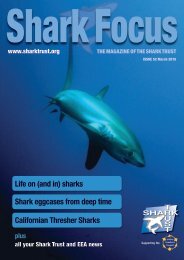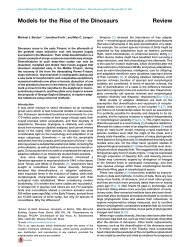(044) Nesbitt et al 2013
(044) Nesbitt et al 2013
(044) Nesbitt et al 2013
You also want an ePaper? Increase the reach of your titles
YUMPU automatically turns print PDFs into web optimized ePapers that Google loves.
Downloaded from http://sp.lyellcollection.org/ at CAPES on May 3, <strong>2013</strong>S. J. NESBITT ET AL.some of these taxa into discr<strong>et</strong>e clades, <strong>al</strong>thoughthere is a long way to go.Here, we briefly synthesize the current understandingof rauisuchians. We highlight current consensusin rauisuchian taxonomy and review thediscr<strong>et</strong>e clades (such as Poposauroidea and Rauisuchidae)that can be identified by derived charactersand that have a similar taxonomic compositionin recent phylogen<strong>et</strong>ic an<strong>al</strong>yses. We <strong>al</strong>so reviewadvances in studies of rauisuchian p<strong>al</strong>aeobiologybeyond systematics. Fin<strong>al</strong>ly, we end with a roadmapof what we consider to be important to futurework on rauisuchians.TerminologyHere, we use Archosauria to refer to the crowngroup defined by the common ancestor of birds andcrocodylians, and <strong>al</strong>l of its descendants (Gauthier &Padian 1985; Gauthier 1986; Sereno 1991). Pseudosuchia(Gauthier & Padian 1985) refers to archosaursmore closely related to crocodylians thanto birds, whereas Avem<strong>et</strong>atars<strong>al</strong>ia (Benton 1999)refers to archosaurs more closely related to birdsthan to crocodylians. Note that sever<strong>al</strong> authors us<strong>et</strong>he clade name Crurotarsi (node-based group origin<strong>al</strong>ly)to refer to what we here c<strong>al</strong>l Pseudosuchia(e.g. Sereno & Arcucci 1990; Sereno 1991; Benton1999, 2004; Brusatte <strong>et</strong> <strong>al</strong>. 2010).In the late 20th century, Rauisuchia Bonaparte1975 came to encompass an assortment of Triassicgenera that were som<strong>et</strong>imes (<strong>al</strong>though not consistentlyand with varying definitions and content) partitionedinto Linnean families such as RauisuchidaeHuene 1942, Ctenosauriscidae Kuhn 1964, PrestosuchidaeRomer 1966, Poposauridae (Nopcsa1923) and Chatterjeeidae Long & Murry 1995 (seeGower 2000; <strong>Nesbitt</strong> 2011 for further discussion).In that ‘Rauisuchia’, as understood here, includesgenera gener<strong>al</strong>ly referred to these higher taxa, it ishighly likely to be non-monophyl<strong>et</strong>ic and is thereforeused in inverted commas. Rauisuchians, inthe sense used here, are best defined as <strong>al</strong>most <strong>al</strong>lsuchians that are not members of A<strong>et</strong>osauria orCrocodylomorpha, with addition<strong>al</strong> exceptions comprisinga few non-rauisuchian, possible suchianssuch as Gracilisuchus stipanicicorum and Turfanosuchusdabanensis. Other than Parrish (1993), whoredefined Rauisuchia to apply to a clade that <strong>al</strong>soincluded Crocodylomorpha, most authors since the1990s have understood ‘Rauisuchia’ and rauisuchiansin the sense used here.Phylogen<strong>et</strong>ic definitionsShifting ideas (most not strongly supported) aboutthe relationships among rauisuchians and otherpseudosuchians has led to a number of ch<strong>al</strong>lengeswhen presenting a natur<strong>al</strong> classification based onexplicit phylogen<strong>et</strong>ic definitions (sensu de Queiroz& Gauthier 1990, 1992). Most workers who haveapplied numeric<strong>al</strong> phylogen<strong>et</strong>ic m<strong>et</strong>hods agree that‘Rauisuchia’ is not monophyl<strong>et</strong>ic, and most haveconverted pre-cladistic names to clade names (e.g.Rauisuchidae: Parrish 1993). Some authors hav<strong>et</strong>ied explicit definitions to these latter two types ofclade names (e.g. Sereno <strong>et</strong> <strong>al</strong>. 2005; Weinbaum& Hungerbühler 2007; Brusatte <strong>et</strong> <strong>al</strong>. 2010), butothers have not (e.g. Parrish 1993).To add to the confusion, different authors evenin the cladistic age have used various names torefer to clades with a similar composition and/orthe same names for different groups (compare, forexample, the use of Rauisuchia by Gauthier (1986)and Parrish (1993) and the use of Rauisuchidae byParrish (1993) and Brusatte <strong>et</strong> <strong>al</strong>. (2010) and<strong>Nesbitt</strong> (2011)). Although the higher-level relationshipsof rauisuchians in the most recent large-sc<strong>al</strong>ean<strong>al</strong>yses (Brusatte <strong>et</strong> <strong>al</strong>. 2010; Butler <strong>et</strong> <strong>al</strong>. 2011;<strong>Nesbitt</strong> 2011) are far from full agreement, sever<strong>al</strong>sm<strong>al</strong>ler clades of rauisuchians are compatible (Fig.2). Therefore, the following list of clade definitionsis split into two sections. The first s<strong>et</strong> of cladenames refers to groups that have been found inrecent an<strong>al</strong>yses using different data s<strong>et</strong>s, and thusappear to be relatively stable. The second s<strong>et</strong> refersto monophyl<strong>et</strong>ic groups that have been found insome an<strong>al</strong>yses, but denote a s<strong>et</strong> of either paraphyl<strong>et</strong>icor polyphyl<strong>et</strong>ic groups in other an<strong>al</strong>yses. The cladenames in the second s<strong>et</strong> should be re-ev<strong>al</strong>uated ifsubsequent phylogen<strong>et</strong>ic an<strong>al</strong>yses find that theclades, as defined by the phylogen<strong>et</strong>ic definitions,turn out to include other pseudosuchians (e.g. A<strong>et</strong>osauria)not intention<strong>al</strong>ly included in the definition.First s<strong>et</strong>Rauisuchidae Huene 1942. Stem-based definition –the most inclusive clade containing Rauisuchus tiradentesHuene 1938b but not A<strong>et</strong>osaurus ferratusFraas 1877, Prestosuchus chiniquensis Huene1938b, Poposaurus gracilis Mehl 1915 or Crocodylusniloticus (Laurenti 1768). (Sensu Sereno <strong>et</strong> <strong>al</strong>.2005.)Poposauroidea Nopcsa 1923. Stem-based definition– the most inclusive clade containing Poposaurusgracilis Mehl 1915 but not Rauisuchustiradentes Huene 1938b, Crocodylus niloticus(Laurenti 1768), Ornithosuchus longidens (Huxley1877) or A<strong>et</strong>osaurus ferratus Fraas 1877. (SensuWeinbaum & Hungerbühler 2007.)Shuvosauridae. Node-based definition – theleast inclusive clade containing Shuvosaurusinexpectatus Chatterjee 1993 and Sillosuchus




